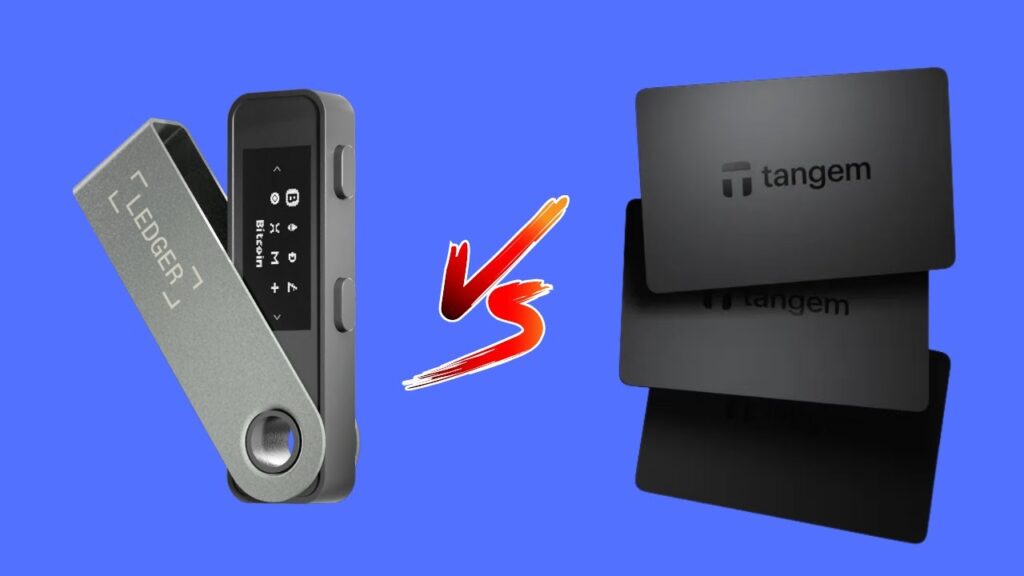Introduction to Hardware Wallets
When it comes to securing your cryptocurrency, hardware wallets are often considered the safest option. Unlike software wallets, which are vulnerable to online hacks, hardware wallets store your private keys offline, providing a high level of security. Two of the most popular options today are the Tandem Wallet and the Ledger Crypto Wallet. In this article, we’ll compare Tandem and Ledger by breaking down their security features, ease of use, supported cryptocurrencies, pricing, and additional features to help you make an informed decision.
Overview of Tandem Wallet and Ledger Wallet
Both Tandem and Ledger are hardware wallets designed to store cryptocurrency securely, but their approaches differ significantly.
Tandem Wallet
The Tandem wallet is a card-based hardware wallet that resembles a credit card, utilizing NFC technology. This allows users to access their crypto simply by tapping the card against a smartphone.
Ledger Wallet
In contrast, the Ledger wallet is a USB-style hardware wallet requiring connection to a computer or mobile device to access funds. It operates through the Ledger Live app, which manages transactions and portfolio tracking.
Security Features
Security is the primary reason people choose hardware wallets over software wallets, so let’s delve into how each wallet protects your funds.
Tandem Wallet Security
- No Private Key Exposure: Tandem generates and stores private keys inside a secure chip in the card, making extraction impossible.
- NFC-Based Authentication: You only need your Tandem card and smartphone to access funds; no passwords or PINs required.
- Tamperproof Hardware: Any physical alteration to the card renders it useless.
- Offline Operation: The wallet operates offline, preventing hacking attempts.
- Multi-card Backup: Users can set up multiple cards for redundancy.
Ledger Wallet Security
- Secure Element (SE): Ledger uses the same type of chip found in credit cards and passports to protect private keys.
- PIN Protection: A PIN code is required each time you access the wallet.
- Recovery Phrase: It generates a 24-word seed phrase for fund recovery if the device is lost.
- Firmware Updates: Regular updates help protect against vulnerabilities.
- Multi-signature and Passphrase Protection: These add extra layers of authentication.
Which is More Secure?
Ledger provides a more robust security framework, including PIN access and recovery seed phrases. However, this complexity can make it less user-friendly. Tandem offers a straightforward, tamperproof card system, relying on NFC-enabled smartphones for access.
Ease of Use and Accessibility
An effective hardware wallet should be easy to use while still providing top-tier security.
Tandem Wallet Ease of Use
- No Setup Required: Simply tap your phone on the card, and you’re good to go—no PINs or seed phrases needed.
- Mobile-Only Access: Requires an NFC-enabled smartphone, with no software installation necessary.
Ledger Wallet Ease of Use
- Requires Ledger Live App: This app manages transactions, tracks portfolios, and monitors crypto holdings.
- Setup Steps: Involves generating a PIN code and a 24-word recovery phrase.
- Compatible with Desktop and Mobile: Works with Android, iOS, Windows, Macs, and Linux, but requires a USB connection for transactions.
Which is More Convenient?
The Tandem wallet is easier to use due to its instant functionality without the need for passwords or PINs. Ledger, while offering more control and features, is slightly less convenient, requiring a USB connection.
Supported Cryptocurrencies
The number of cryptocurrencies supported is crucial when choosing a hardware wallet.
Tandem Wallet Supported Coins
Tandem supports major cryptocurrencies such as Bitcoin (BTC), Ethereum (ETH), USDT, XRP, and Binance Coin, along with some limited support for smaller altcoins largely focused on Ethereum-based tokens (ERC20).
Ledger Wallet Supported Coins
Ledger boasts support for over 5,500 cryptocurrencies, including Bitcoin, Ethereum, BNB, Solana, and many others. Additionally, it supports staking and DeFi integration.
Which Wallet Supports More Coins?
Ledger is the clear winner, supporting thousands of cryptocurrencies, while Tandem’s offerings are primarily limited to major assets.
Pricing and Cost
The cost of a hardware wallet is an important factor in your decision-making.
Tandem Wallet Pricing
- Single Card: Approximately $55.
- Three-Card Backup Pack: Around $90 for redundancy.
Ledger Wallet Pricing
- Ledger Nano S+: Approximately $80.
- Ledger Nano X: Around $150, featuring Bluetooth and mobile connectivity.
Which is More Affordable?
Tandem is the cheaper option for basic use, while Ledger’s higher price point is justified by its advanced features.
Pros and Cons
Tandem Wallet Pros and Cons
Pros:
- Simple to use; no seed phrase or PIN requirement.
- Affordable pricing.
- Completely tamperproof.
Cons:
- Requires an NFC smartphone.
- Limited cryptocurrency support.
Ledger Wallet Pros and Cons
Pros:
- Industry-leading security with PIN and recovery phrase.
- Supports over 5,500 cryptocurrencies.
- Compatibility with DeFi and staking; Ledger Live app for management.
Cons:
- More complex setup.
- Requires USB or Bluetooth connection.
Conclusion: Which Wallet Should You Choose?
Choose Tandem Wallet if you seek a simple, mobile-friendly wallet that is easy to use and tamperproof without the hassle of passwords or PINs. It’s ideal for casual crypto holders looking for convenience.
Opt for Ledger Wallet if you need advanced security and functionality, including staking, DeFi access, and support for thousands of cryptocurrencies. It’s best suited for serious investors who require long-term security and complete control over their assets.
Both wallets have their strengths. Pick the one that best aligns with your crypto storage and management style.
If this article has been helpful, please leave a like and subscribe. Thank you for reading!

 | Step-by-Step Guide for Freelancers & Online Sellers
| Step-by-Step Guide for Freelancers & Online Sellers | Step-by-Step Canva Quiz Maker Tutorial
| Step-by-Step Canva Quiz Maker Tutorial | Best Crypto Wallet for Cold Storage & Security?
| Best Crypto Wallet for Cold Storage & Security?
 | Temu Affiliate Program Guide for Beginners
| Temu Affiliate Program Guide for Beginners | How to Use Simple Earn to Grow Your Crypto Easily
| How to Use Simple Earn to Grow Your Crypto Easily